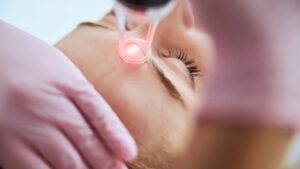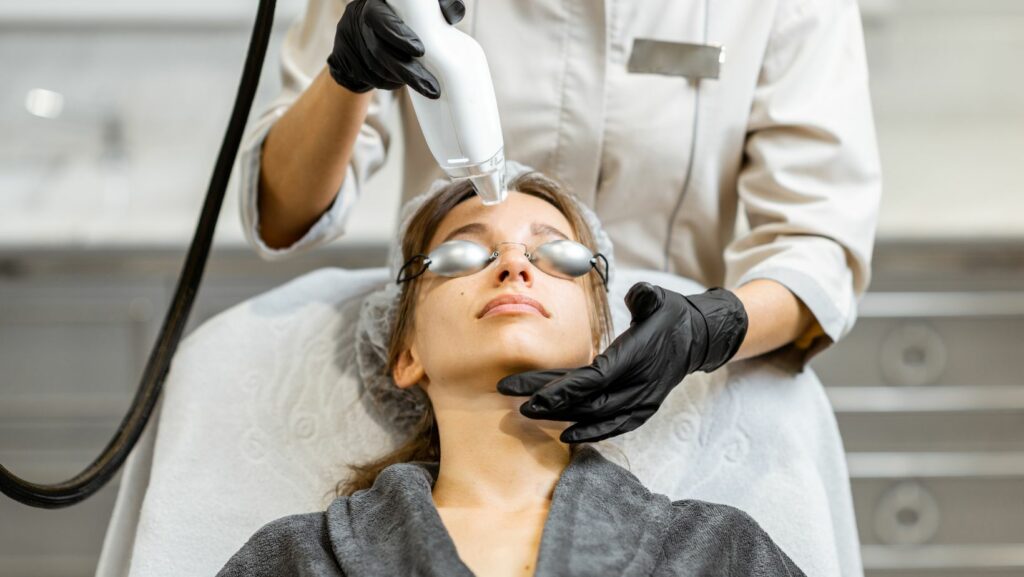![]()
![]() Laser Treatments
Laser Treatments
Laser treatments use concentrated light energy to address various medical and cosmetic concerns. Specific wavelengths of light target particular tissues or cells, causing minimal damage to surrounding areas. For example, different lasers can target the melanin in hair follicles, hemoglobin in blood vessels, or water in the skin. The versatility of laser treatments allows them to be applied in dermatology, ophthalmology, and other medical fields. In dermatology, lasers treat conditions like acne scars and pigmentation disorders. In ophthalmology, they correct vision issues such as myopia and astigmatism. These procedures offer precision, reducing recovery time and enhancing patient outcomes. Safety and efficacy are crucial in laser treatments. Qualified professionals evaluate the patient’s skin type, condition, and treatment goals. Proper calibration of laser settings is essential to maximize results while minimizing side effects. Ongoing research continues to expand the potential applications of lasers, making them an integral part of modern medical and cosmetic treatments.
Laser treatments cover a wide range of applications, addressing both cosmetic and medical needs. Each treatment type utilizes specific laser technology tailored to achieve precise results. Cosmetic lasers enhance physical appearance by targeting various skin issues. Common treatments include laser hair removal, which uses specific wavelengths to destroy hair follicles and prevent regrowth. Skin resurfacing improves texture and tone by removing outer skin layers. Intense Pulsed Light (IPL) helps reduce pigmentation, age spots, and vascular lesions. These non-invasive procedures often provide noticeable results with minimal downtime.
Medical lasers address various health conditions with high precision. In ophthalmology, treatments like LASIK and PRK correct vision impairments such as myopia by reshaping the cornea. In vascular surgery, lasers treat varicose veins by sealing them shut. Oncology uses lasers for tumor ablation, directly targeting cancer cells. Dentists employ lasers for cavity treatment and gum surgery, promoting faster healing. Medical laser applications often reduce risks associated with traditional surgery. Laser tattoo removal effectively fades unwanted ink. The process involves using Q-switched lasers that emit energy pulses to break down tattoo pigments. Over several sessions, the body gradually eliminates these fragments. Factors like ink color and skin type influence the number of required treatments. Tattoo removal generally results in minimal scarring when performed by trained professionals, offering a safe option for those seeking tattoo modification or elimination.
![]() Benefits of Laser Treatments
Benefits of Laser Treatments
Laser treatments offer numerous advantages in both cosmetic and medical domains. Their precision and efficiency make them a preferred choice for various procedures. Laser treatments excel in precision and accuracy. They target specific tissues or cells with concentrated light energy, minimizing damage to surrounding areas. This accuracy allows for effective interventions in dermatology and ophthalmology, reducing wrinkles, correcting vision issues, and treating acne scars with minimal collateral tissue impact.
These treatments are minimally invasive, generating targeted results with minimal discomfort. Unlike traditional surgery, lasers leave surrounding skin and tissue largely unharmed. Procedures like laser hair removal and skin resurfacing showcase this capability by providing effective results without significant incisions.
Laser treatments typically result in faster recovery times compared to conventional surgical methods. Patients often experience reduced downtime due to the precision of targeting and the minimally invasive nature of the procedures. This aspect is crucial for individuals seeking efficient cosmetic improvements or medical corrections while minimizing disruption to their daily routines.
![]() Potential Risks and Side Effects
Potential Risks and Side Effects
Laser treatments, while effective, carry potential risks and side effects. Understanding these helps ensure informed decisions. Temporary skin irritation may occur post-treatment. Redness and swelling are common in treated areas. These symptoms generally subside within a few days. Cooling measures and moisturizers can aid recovery.
Hyperpigmentation involves darkening of the skin post-laser treatment. It occurs more frequently in individuals with darker skin tones. Proper assessment by professionals reduces occurrence. Pre-treatment testing and sun protection further mitigate risk.
Laser treatments have revolutionized both cosmetic and medical fields by offering precise, efficient solutions for a variety of concerns. Their ability to target specific areas while minimizing damage to surrounding tissues makes them a preferred choice for many seeking minimally invasive options. With ongoing advancements and research, the scope of laser applications continues to grow, promising even more innovative solutions in the future. Choosing a qualified professional and facility remains essential to ensure safety and achieve optimal results. As technology progresses, laser treatments will undoubtedly remain at the forefront of modern medical and cosmetic advancements.

